Yanagisawa T901 tenor saxophone
 Origin:
Japan (www.yanagisawasax.co.jp) Origin:
Japan (www.yanagisawasax.co.jp)
Guide price: £2200
Weight: 3.13kg
Date of manufacture: 2005 (approx)
Date reviewed: February 2015
A fine tenor that competes on every level
with the renowned Yamaha 62
I've always felt that the £2000 price point marks the sweet
spot for saxes. In years gone by (when £2000 was more like
a grand or so) it was generally accepted that this was what you
had to pay for a professional horn. Anything below it was clearly
for amateurs, anything above was unnecessary. Life was simple, times
were good.
And then everything changed. 'Supersaxes' appeared on the market,
costing half as much again...sometimes twice or even three times
as much. Players who'd bought what they thought were pro horns suddenly
found their pride and joy had been downgraded to 'entry level pro'.
At least that's what the manufacturers (and the retailers) wanted
you to believe - but not everyone was fooled.
It all boils down to the law of diminishing returns. If you drew
up a graph of the cost of a horn against its playability you'd see
a fairly steep rise as you went from, say, £300 to £600,
and a reasonably steep rise in the £600 to £1000 bracket.
Thereafter the curve flattens out somewhat, and by the time you're
at the £1500 mark it should start to become clear that everything
above this price point is generally pretty good.
By the time you get to £2000 the price v quality curve is
starting to run out of steam, and the gain you could have had for
£500 at the lower end of the scale will now cost you double
or triple that amount. The more you pay, the less you gain.
That's why the two grand mark is the sweet spot - and it's why horns
like the Yanagisawa 901 and the Yamaha 62 have proved to be so incredibly
popular. It's also why the Taiwanese chose (wisely) to invade this
price point in recent years.
In this price range I've reviewed the venerable 62, and a Mauriat
or two...and the remarkable TJ RAW - now it's the turn of the Yanagisawa
901 to get a good shakedown...
The body has all the usual features of a contemporary horn; detachable
bell, triple-point bell stay, adjustable thumb hook (metal, with
those dubious dimples on the base), titling bell key table, removable
side F# key guard and a large, slightly domed thumb rest.
The construction is single pillar, and each pillar has a suitably
wide base. This makes the horn more reliable - those large bases
will shrug off a casual knock, and it's unlikely they'll ever pop
off due to internal stresses (a common problem with many Chinese
and cheap old East German horns).
The compound bell key pillar is a standalone too, but with a very
generously-proportioned base.
 It's
a slightly different affair at the palm keys though, which feature
box (or U-channel) pillars. They should be sturdy enough, but my
biggest concern is that there's not much meat on the threaded end
of the pillar. It's probably not much of a concern - but you know
me, I like a pair of braces with my belt - and from an aesthetic
point of view they look a bit industrial. It's
a slightly different affair at the palm keys though, which feature
box (or U-channel) pillars. They should be sturdy enough, but my
biggest concern is that there's not much meat on the threaded end
of the pillar. It's probably not much of a concern - but you know
me, I like a pair of braces with my belt - and from an aesthetic
point of view they look a bit industrial.
No such problems with the bell key guard stays - nice and beefy.
These will spread the load of a light knock with ease, and won't
pop off on their own accord.
As per the modern standard, the tone holes are drawn from the body
- and I'm pleased to say they're nice and level.
The bell key guards feature adjusters for the bumpers, and these
are made from plastic. My initial reaction was 'cheap and nasty'
- but in fact it's probably quite a good idea. First up there's
the weight saving. OK, so it's not going to be much - but a gramme
saved here can be used elsewhere. Then there's the anti-rattle properties.
Bumper adjusters often seem to work loose, and when they do they
tend to add a slight buzz to the lower notes. Not many players are
aware of this and often won't address the problem until the things
start to rattle.
And then there's the anti-seize properties. A brass thread in a
brass socket that doesn't see much use can lock up solid over a
period of time - but there'll be no such issues with a plastic thread.
And anyway, they look kinda cool.
The lacquered finish is excellent. This particular example is ten
years old, and only had a couple of minor blemishes. This should
be par for the course for a horn of this age, though it should be
noted that it hadn't seen that much use. I have to say, though,
that I'm never surprised to see the odd brown spot under the lacquer
of a Yanagisawa...
 The
keywork is very nicely built and finished - with the standout features
being a very slick teardrop-shaped touchpiece on the front top F
key and a sculpted octave key that's very comfortable under the
thumb...and all powered by a set of blued steel springs. I was also
very pleased to see proper mother-of-pearl touches. It's a small
thing, but it makes such a difference to the feel when things get
hot and sweaty. The
keywork is very nicely built and finished - with the standout features
being a very slick teardrop-shaped touchpiece on the front top F
key and a sculpted octave key that's very comfortable under the
thumb...and all powered by a set of blued steel springs. I was also
very pleased to see proper mother-of-pearl touches. It's a small
thing, but it makes such a difference to the feel when things get
hot and sweaty.
The pads are decent enough, and fitted with plastic reflectors/resonators.
I like these - they shrug off the dirt and are easy to clean, and
they're less inclined to turn the leather green beneath them. Some
players claim the material the reflectors are made from makes a
difference to the tone - and you can believe that if you like...but
I don't.
As I had to change a couple of pads I took one apart and noted that
they're not fitted with a waterproof cellophane disc beneath the
leather. I wouldn't be particularly concerned about that.
 I
was disappointed to find that no adjusters are fitted to the main
stacks. On a horn of this quality I'd have liked to have seen regulation
adjusters at least...and height adjusters would have been nice.
It makes the job of setting the stack regulation so much easier,
and allows the confident home tweaker to make small adjustments
inbetween service schedules. I
was disappointed to find that no adjusters are fitted to the main
stacks. On a horn of this quality I'd have liked to have seen regulation
adjusters at least...and height adjusters would have been nice.
It makes the job of setting the stack regulation so much easier,
and allows the confident home tweaker to make small adjustments
inbetween service schedules.
Adjusters are provided for the Bis Bb, G# and low C# - and there's
an additional one on the F# helper arm. I remain sceptical about
the value of the latter, given that the arm is quite long and therefore
quite flexible (unlike, say, the one fitted to the Keilwerth SX90R,
which is short and stout).
Proper point screws are used, and these are secured with threadlock
- which means there's a bit of adjustment built in. When the time
comes to take up any play in the keys that pivot on them, all that'll
be needed is for the screws to be given a quarter of a turn or so.
As a rough estimate I'd say you'd get about three or four goes at
this before the pillars will need reaming (to allow the points screws
to go in further). When that might be necessary depends on how much
you use the horn and how well you keep it lubricated, but for the
casual player it might be decades before such work is required.
 The
side top E and F# key barrels are fitted with an anti-whip clamp.
When such long keys are pressed, there's a tendency for the barrels
to flex under the strain - and the clamp prevents them from doing
so. It would be far more effective were it fitted to the low B/Bb
key barrels, where 'whippage' will compromise the seat of the pad.
Still, at least it serves to protect the side key barrels from bending
due to incautious handling. The
side top E and F# key barrels are fitted with an anti-whip clamp.
When such long keys are pressed, there's a tendency for the barrels
to flex under the strain - and the clamp prevents them from doing
so. It would be far more effective were it fitted to the low B/Bb
key barrels, where 'whippage' will compromise the seat of the pad.
Still, at least it serves to protect the side key barrels from bending
due to incautious handling.
The whole outfit comes in a very nice box case, complete with proper
catches. It's perhaps a tad bulky, but it's very well padded. My
only real point of note is that the outer covering of the lid and
base has a layer of padding beneath it, and as such is more inclined
to tear if you run into something sharp. Just avoid doing so and
you'll be fine.
In terms of feel the 901 fits nicely under the fingers. Yanagisawa
have always had a good reputation when it comes to ergonomics, and
certain aspects of the design show that much thought has been put
into this area. The action is undoubtedly very good, but I still
feel that Yamaha have the edge here. I can't explain it in any meaningful
way, but no matter how much I fiddle with and tweak the action I
can never quite get that 'oh yeah' feeling I get from a Yamaha.
It'll probably be down to something daft, like the cup angles or
the position of the key pearls - but either way it's there. For
me, anyway.
It's also worth mentioning that the 901 is quite a light horn. At
3.13kg it's about the same weight as the Yamaha YTS23 - which makes
it one of the lightest tenors on the market.
Tonewise the 901 is what I'd call a very confident horn; its presentation
is bold, even strident - and yet there's and underlying warmth to
it. It puts me in mind of a city slicker, dressed in a sharp suit,
with an armful of carefully presented reports and graphs...but if
you look very closely at his tie you'll see there's a little teddy
bear embroidered on it.
It's also a very even-tempered tone, which means it's quite uniform
up and down the scale, though it opens out a little at the top end.
The advantage of this approach is that it makes for a very versatile
horn, but the payoff is a slight lack of fizz and crackle. And it
is only slight, but it's there nonetheless.
I think this explains why I'm seeing more classical players turning
up with Yanagisawas these days. It's not that the 901 is staid,
or particularly 'serious', it's perhaps more about it being a steady
and stable performer at all volumes - though it has plenty of response
to allow it to kick off nicely when you push it.
And the tuning is spot on, as you'd expect.
The obvious competitor to the 901 is the Yamaha 62. It's around
the same price but the tone and presentation is brighter...more
forward. There was a time when I'd have said it was an even toss-up
between the two in terms of build and ergonomics, with the only
real difference being your preference for tone and response - but
the recent Yamahas I've worked on have not been as well put together
as I'd expect, which puts the Yanagisawa a little way ahead in the
running.
But picking up the city slicker analogy, the 62 would have the same
sharp suit (though it would be Italian), he'd be missing a couple
of reports and if you looked closely at his tie you'd see where
he once spilt a Martini on it. 901 man prefers to go into a meeting
with all the facts and figures laid out on paper - 62 man prefers
to wing it a little.
Up until a few years ago that would have been the end of the analogy,
but with the arrival of the new TJ Signature Custom range this sector
of the market has had a bit of a kick up the pants. The basic lacquered
model comes in at around £2300 and combines the build quality
and depth of tone of the 901 with the zing and fizz of the 62 -
and, frankly, you can't ignore it.
The 901 is a solid horn, both in terms of build quality and performance.
Sure, I have a few niggles - but then that's my job, but my overall
impression is that you very definitely get what you pay for. At
a touch over two grand, that's quite a lot...quite a lot indeed.
|



